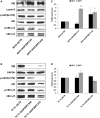Insulin-Like Growth Factor 2 mRNA-Binding Protein 3 Influences Sensitivity to Anti-IGF System Agents Through the Translational Regulation of IGF1R
- PMID: 29731738
- PMCID: PMC5919949
- DOI: 10.3389/fendo.2018.00178
Insulin-Like Growth Factor 2 mRNA-Binding Protein 3 Influences Sensitivity to Anti-IGF System Agents Through the Translational Regulation of IGF1R
Abstract
Insulin-like growth factor 2 (IGF2) mRNA-binding protein 3 (IGF2BP3) is an oncofetal protein that binds RNA, thereby influencing the fate of target transcripts. IGF2BP3 is synthesized de novo in cancer, where it promotes proliferation, drug resistance, and metastasis via both IGF2-dependent and IGF2-independent mechanisms. Ewing sarcoma (ES) is a rare bone and soft tissue tumor in which the IGF system plays a pivotal role. This study aimed to investigate the effect of IGF2BP3 on the regulation of the IGF system in ES. Among the components of the IGF axis, a direct significant correlation was identified between IGF2BP3 and IGF1R at mRNA and protein levels in two independent series of clinical specimens from patients with localized ES. After the formal demonstration of a direct association between IGF2BP3 and IGF1R mRNA using ribo-immunoprecipitation assay, we performed in vitro studies using A673 and TC-71 ES cell lines to demonstrate that IGF2BP3 loss promotes the downregulation of IGF1R and a decreased biological response to IGF1, represented by reduced migration and cell growth. Additionally, the compensatory activation of insulin receptor (IR) and its mitogenic ligand IGF2 is triggered in some but not all cell lines in response to IGF2BP3-mediated IGF1R loss. These findings have therapeutic implications because cells with a decreased expression of IGF2BP3/IGF1R axis but an increased expression of the IR/IGF2 loop display higher sensitivity to the dual inhibitor OSI-906 than do control cells. Therefore, studies on IGF2BP3, which was confirmed as a post-transcriptional regulator of IGF1R, provide a step forward in the identification of new mechanisms regulating the IGF system. In addition, our results demonstrate that the detection of IGF2BP3 expression should be combined with the assessment of the IGF1R/IR ratio to predict cell responses to anti-IGF1R/IR agents.
Keywords: Ewing sarcoma; IGF1R; anti-IGF agents; insulin-like growth factor 2 mRNA-binding protein 3; personalized treatment.
Figures





Similar articles
-
THADA fusion is a mechanism of IGF2BP3 activation and IGF1R signaling in thyroid cancer.Proc Natl Acad Sci U S A. 2017 Feb 28;114(9):2307-2312. doi: 10.1073/pnas.1614265114. Epub 2017 Feb 13. Proc Natl Acad Sci U S A. 2017. PMID: 28193878 Free PMC article.
-
Insulin-Like Growth Factor 2 mRNA-Binding Protein 3 is a Novel Post-Transcriptional Regulator of Ewing Sarcoma Malignancy.Clin Cancer Res. 2018 Aug 1;24(15):3704-3716. doi: 10.1158/1078-0432.CCR-17-2602. Epub 2018 Apr 27. Clin Cancer Res. 2018. PMID: 29703820
-
A pivotal role for heat shock protein 90 in Ewing sarcoma resistance to anti-insulin-like growth factor 1 receptor treatment: in vitro and in vivo study.Cancer Res. 2008 Aug 1;68(15):6260-70. doi: 10.1158/0008-5472.CAN-07-3074. Cancer Res. 2008. PMID: 18676850
-
Insulin/Insulin-like growth factors in cancer: new roles for the aryl hydrocarbon receptor, tumor resistance mechanisms, and new blocking strategies.Front Endocrinol (Lausanne). 2015 Feb 2;6:12. doi: 10.3389/fendo.2015.00012. eCollection 2015. Front Endocrinol (Lausanne). 2015. PMID: 25699021 Free PMC article. Review.
-
Insulin-like growth factors in human breast cancer.Breast Cancer Res Treat. 1998;52(1-3):175-84. doi: 10.1023/a:1006127621512. Breast Cancer Res Treat. 1998. PMID: 10066081 Review.
Cited by
-
Polymorphic variants of IGF2BP3 and SENCR have an impact on predisposition and/or progression of Ewing sarcoma.Front Oncol. 2022 Oct 21;12:968884. doi: 10.3389/fonc.2022.968884. eCollection 2022. Front Oncol. 2022. PMID: 36338681 Free PMC article.
-
RNA N6-methyladenosine reader IGF2BP3 promotes acute myeloid leukemia progression by controlling stabilization of EPOR mRNA.PeerJ. 2023 Aug 30;11:e15706. doi: 10.7717/peerj.15706. eCollection 2023. PeerJ. 2023. PMID: 37663284 Free PMC article.
-
IGF2BP3 May Contributes to Lung Tumorigenesis by Regulating the Alternative Splicing of PKM.Front Bioeng Biotechnol. 2020 Sep 2;8:679. doi: 10.3389/fbioe.2020.00679. eCollection 2020. Front Bioeng Biotechnol. 2020. PMID: 32984260 Free PMC article.
-
IGF2BP3 From Physiology to Cancer: Novel Discoveries, Unsolved Issues, and Future Perspectives.Front Cell Dev Biol. 2020 Jan 15;7:363. doi: 10.3389/fcell.2019.00363. eCollection 2019. Front Cell Dev Biol. 2020. PMID: 32010687 Free PMC article. Review.
-
Unraveling the Resistance of IGF-Pathway Inhibition in Ewing Sarcoma.Cancers (Basel). 2020 Nov 29;12(12):3568. doi: 10.3390/cancers12123568. Cancers (Basel). 2020. PMID: 33260481 Free PMC article. Review.
References
LinkOut - more resources
Full Text Sources
Other Literature Sources
Miscellaneous

